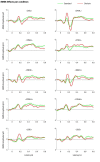Asymmetries in Accessing Vowel Representations Are Driven by Phonological and Acoustic Properties: Neural and Behavioral Evidence From Natural German Minimal Pairs
- PMID: 33679344
- PMCID: PMC7930067
- DOI: 10.3389/fnhum.2021.612345
Asymmetries in Accessing Vowel Representations Are Driven by Phonological and Acoustic Properties: Neural and Behavioral Evidence From Natural German Minimal Pairs
Abstract
In vowel discrimination, commonly found discrimination patterns are directional asymmetries where discrimination is faster (or easier) if differing vowels are presented in a certain sequence compared to the reversed sequence. Different models of speech sound processing try to account for these asymmetries based on either phonetic or phonological properties. In this study, we tested and compared two of those often-discussed models, namely the Featurally Underspecified Lexicon (FUL) model (Lahiri and Reetz, 2002) and the Natural Referent Vowel (NRV) framework (Polka and Bohn, 2011). While most studies presented isolated vowels, we investigated a large stimulus set of German vowels in a more naturalistic setting within minimal pairs. We conducted an mismatch negativity (MMN) study in a passive and a reaction time study in an active oddball paradigm. In both data sets, we found directional asymmetries that can be explained by either phonological or phonetic theories. While behaviorally, the vowel discrimination was based on phonological properties, both tested models failed to explain the found neural patterns comprehensively. Therefore, we additionally examined the influence of a variety of articulatory, acoustical, and lexical factors (e.g., formant structure, intensity, duration, and frequency of occurrence) but also the influence of factors beyond the well-known (perceived loudness of vowels, degree of openness) in depth via multiple regression analyses. The analyses revealed that the perceptual factor of perceived loudness has a greater impact than considered in the literature and should be taken stronger into consideration when analyzing preattentive natural vowel processing.
Keywords: mismatch negativity (MMN); multiple regression analysis; perceived loudness; reaction time (RT); vowel discrimination.
Copyright © 2021 Riedinger, Nagels, Werth and Scharinger.
Conflict of interest statement
The authors declare that the research was conducted in the absence of any commercial or financial relationships that could be construed as a potential conflict of interest.
Figures







Similar articles
-
Neural Processing of Spectral and Durational Changes in Speech and Non-speech Stimuli: An MMN Study With Czech Adults.Front Hum Neurosci. 2021 Aug 9;15:643655. doi: 10.3389/fnhum.2021.643655. eCollection 2021. Front Hum Neurosci. 2021. PMID: 34434094 Free PMC article.
-
Neurophysiological Correlates of Asymmetries in Vowel Perception: An English-French Cross-Linguistic Event-Related Potential Study.Front Hum Neurosci. 2021 Jun 3;15:607148. doi: 10.3389/fnhum.2021.607148. eCollection 2021. Front Hum Neurosci. 2021. PMID: 34149375 Free PMC article.
-
Contrast and Conflict in Dutch Vowels.Front Hum Neurosci. 2021 Jun 7;15:629648. doi: 10.3389/fnhum.2021.629648. eCollection 2021. Front Hum Neurosci. 2021. PMID: 34163338 Free PMC article.
-
Auditory-perceptual interpretation of the vowel.J Acoust Soc Am. 1989 May;85(5):2114-34. doi: 10.1121/1.397862. J Acoust Soc Am. 1989. PMID: 2659639 Review.
-
Evolving theories of vowel perception.J Acoust Soc Am. 1989 May;85(5):2081-7. doi: 10.1121/1.397860. J Acoust Soc Am. 1989. PMID: 2659637 Review.
References
-
- Aichert I., Marquardt C., Ziegler W. (2005). Frequenzen sublexikalischer Einheiten des Deutschen: CELEX-basierte Datenbanken. Neurolinguistik 19, 55–81.
-
- Aleksandrov A. A., Memetova K. S., Stankevich L. N., Uplisova K. O. (2017). Effects of Russian-language word frequency on mismatch negativity in auditory event-related potentials. Neurosci. Behav. Phys. 47, 1043–1050. 10.1007/s11055-017-0510-3 - DOI
-
- Archangeli D. (1988). Aspects of underspecification theory. Phonology 5, 183–207. 10.1017/S0952675700002268 - DOI
LinkOut - more resources
Full Text Sources
Other Literature Sources

